Firewood shed plans offer comprehensive guides to building efficient storage solutions. These plans‚ often available as free PDF downloads‚ include material lists‚ step-by-step instructions‚ and detailed designs to ensure your firewood stays dry and organized. Whether you’re a DIY novice or an experienced builder‚ these plans provide everything needed to construct a durable and stylish shed tailored to your needs.
Understanding the Importance of Firewood Storage
Proper firewood storage is essential for maintaining the quality and usability of your firewood. Exposure to moisture and pests can degrade wood‚ reducing its burn efficiency and creating mold. A well-designed firewood shed protects your wood from the elements‚ ensuring it remains dry and ready for use. Additionally‚ organized storage prevents clutter and makes it easier to access your firewood when needed. Investing in a firewood shed not only extends the life of your firewood but also enhances your outdoor space. Proper storage is a crucial step in maintaining a reliable and efficient firewood supply for heating and cooking needs.
Overview of Firewood Shed Plans and Designs
Firewood shed plans and designs offer a variety of options to suit different needs and preferences. From small‚ compact lean-to sheds to larger‚ multi-cord capacity structures‚ these plans cater to diverse storage requirements. Designs often include detailed layouts‚ such as gabled or sloped roofs‚ to ensure water runoff and durability. Many plans are available as free or premium PDF downloads‚ providing step-by-step instructions‚ material lists‚ and diagrams for easy construction. Whether you prefer modern‚ rustic‚ or functional designs‚ firewood shed plans are adaptable to your space and style‚ ensuring your firewood stays dry and well-organized year-round.
Choosing the Right Firewood Shed Plan
Selecting the ideal firewood shed plan involves evaluating your storage needs‚ available space‚ and design preferences. Plans vary in size‚ from compact 48-inch lean-tos to large 8×16 sheds‚ ensuring a perfect fit for your requirements.
Evaluating Your Storage Needs and Space
Evaluating your storage needs and available space is crucial for selecting the right firewood shed plan. Consider how much firewood you typically store‚ as sheds range from small 2-cord units to larger 5-cord designs. Measure your yard to ensure the shed fits comfortably‚ leaving enough space for easy access and loading. Assess whether a compact lean-to design or a larger freestanding shed suits your property. Additionally‚ think about the shed’s placement relative to your house or furnace for convenience. Matching your storage capacity to your needs ensures efficiency and avoids wasted space. Popular sizes like 8×16 or 48-inch lean-tos offer versatility for various settings.
Popular Firewood Shed Designs and Styles
Popular firewood shed designs include lean-to‚ gabled‚ and modular styles‚ each offering unique benefits. Lean-to sheds are space-efficient and ideal for smaller yards‚ while gabled designs provide greater storage capacity and a traditional look. Modular sheds are versatile and can be expanded as needed. Many plans‚ such as the 8×16 shed‚ are designed to store up to 5 cords of wood‚ combining functionality with style. These designs often feature slatted sides for ventilation‚ durable roofs‚ and elevated floors to protect wood from moisture. Whether modern or rustic‚ these styles cater to various preferences and property layouts‚ ensuring practical and aesthetic appeal.
Considering Local Building Codes and Regulations
Before constructing a firewood shed‚ it’s essential to review local building codes and regulations. These guidelines ensure safety‚ compliance‚ and proper construction standards. Many firewood shed plans‚ such as those offering free PDF downloads‚ include tips for adapting designs to meet local requirements. Factors like shed size‚ placement‚ and materials may need approval. Permits and inspections could be required‚ especially for larger structures. Additionally‚ some plans are designed with regulatory compliance in mind‚ making it easier to navigate the process. Always verify zoning laws and building codes in your area to avoid potential issues during construction.
Materials and Tools Required
Firewood shed plans typically require essential lumber‚ hardware‚ and tools like drills‚ saws‚ and hammers. Weather-resistant wood and durable fasteners ensure longevity and structural integrity.
Essential Lumber and Hardware
Building a firewood shed requires durable‚ weather-resistant lumber and hardware to ensure longevity. Typical materials include pressure-treated 2x4s or 2x6s for framing‚ plywood or OSB for walls‚ and roofing materials like asphalt shingles. Hardware such as galvanized screws‚ nails‚ and hinges is essential for assembly. Some plans specify using skids for elevation‚ while others recommend concrete footings for stability. Detailed cut lists and shopping lists are often provided in PDF plans‚ ensuring you have everything needed before starting construction. Proper material selection is crucial to protect your firewood from moisture and pests while maintaining structural integrity.
Recommended Power Tools for Construction
Building a firewood shed efficiently requires the right power tools. A circular saw is essential for cutting lumber to size‚ while a drill and impact driver handle screws and bolts. A miter saw can be useful for precise angled cuts‚ though not always necessary. Sanding tools and a jigsaw may also come in handy for finishing touches. Pneumatic nailers can speed up the framing process. Safety equipment like gloves and goggles is crucial. Even with basic tools‚ most DIYers can successfully construct a shed using the detailed guides in firewood shed PDF plans‚ ensuring a professional finish without specialized machinery.
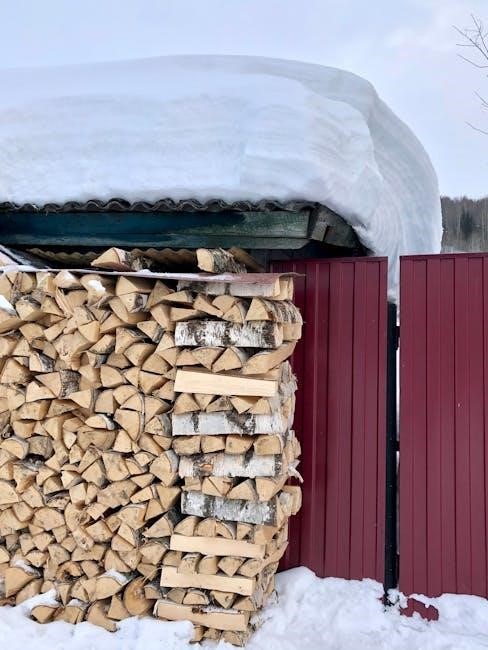
Sizes and Capacities of Firewood Sheds
Firewood sheds come in various sizes and capacities‚ from small 2×3 units storing 0.15 cords to large 8×16 designs holding up to 5 cords of wood‚ ensuring efficient storage solutions.
Understanding Cord Capacity and Dimensions
A cord of firewood measures 4 feet high‚ 4 feet wide‚ and 8 feet long. Firewood sheds are designed to store varying cord capacities‚ from small 0.15-cord units to large 5-cord sheds. Dimensions vary widely‚ with popular sizes like 2×3 feet for minimal storage or 8×16 feet for extensive needs. Lean-to designs often have smaller footprints‚ while larger sheds may include multiple bays or stacked storage. Plans typically specify measurements‚ ensuring the shed fits available space while accommodating the desired wood volume. Understanding cord capacity and dimensions helps users select the right plan for their firewood storage requirements.
Popular Shed Sizes for Different Needs
Firewood shed plans cater to various storage needs‚ offering sizes from compact 2×3 feet (0.15 cords) to spacious 8×16 feet (5 cords). Small sheds‚ like 48-inch lean-tos‚ are ideal for limited space‚ while larger designs accommodate extensive wood supplies. Popular sizes include 4×8 feet for 1 cord‚ 6×8 feet for 2 cords‚ and 8×12 feet for 3 cords. These plans often feature adaptable designs‚ such as single or double bays‚ to suit different households. Whether storing a small winter supply or a large seasonal stockpile‚ there’s a shed size to match your needs and available space effectively.
Design Considerations for Firewood Sheds
Firewood sheds should prioritize structural integrity‚ weather resistance‚ and proper drainage. Designs often include slatted sides for airflow and elevated floors to protect wood from moisture damage effectively.
Structural Integrity and Durability
Ensuring structural integrity is crucial for firewood sheds to withstand harsh weather and last for years. Plans often specify treated lumber for resistance to rot and insect damage. Elevated floors‚ supported by concrete deck blocks or skids‚ prevent moisture from seeping into the wood. Sturdy roof designs‚ such as gabled or lean-to styles‚ provide excellent weather protection; Hardware like hurricane clips and reinforced framing ensures stability. Proper assembly techniques and materials selection are emphasized in PDF plans to guarantee durability. These features collectively create a robust structure that safeguards firewood and maintains its condition over time.
Aesthetic Considerations and Customization Options
Firewood shed plans often include aesthetic considerations to complement your property’s style. Many designs feature slatted sides‚ decorative trim‚ and paint-ready materials for a polished look. Customization options allow you to tailor the shed’s appearance‚ such as choosing roof styles‚ adding windows‚ or incorporating unique finishes like metal roofing. Some plans offer modular designs‚ enabling you to expand or modify the structure as needed. With various siding materials and color options‚ you can match the shed to your home or yard decor. These customizable elements ensure your firewood shed is both functional and visually appealing‚ enhancing your outdoor space while meeting your practical needs.
Building Instructions and Guides
Firewood shed plans provide step-by-step instructions and detailed guides for construction. These resources include diagrams‚ cut lists‚ and assembly tips to ensure a secure and efficient build process.
Step-by-Step Construction Process
Firewood shed plans typically outline a detailed‚ step-by-step construction process to ensure a successful build. Begin by preparing the site‚ ensuring it is level and clear of debris. Next‚ assemble the floor frame using treated lumber and secure it with concrete footings or skids. Construct the walls‚ starting with the back and sides‚ then the front‚ ensuring proper alignment and structural integrity. Install roofing materials‚ such as asphalt shingles or metal‚ over a sturdy frame. Add doors and vents for easy access and airflow. Finish with exterior trim and paint for protection and aesthetics. Follow the plans closely for a durable‚ functional shed.
Common Mistakes to Avoid During Assembly
When building a firewood shed‚ avoid common mistakes that can compromise its durability and functionality. Incorrect measurements during framing can lead to misaligned walls and roofing issues. Ensure the site is properly leveled and secured to prevent structural instability. Neglecting to use treated lumber for floor and foundation components can result in rot and pest damage. Additionally‚ failing to follow local building codes or ignoring ventilation requirements can lead to moisture buildup and fire hazards. Always double-check plans‚ pre-drill holes to avoid splitting wood‚ and seal gaps to ensure a weather-tight structure. Proper preparation and attention to detail are key to a successful assembly.
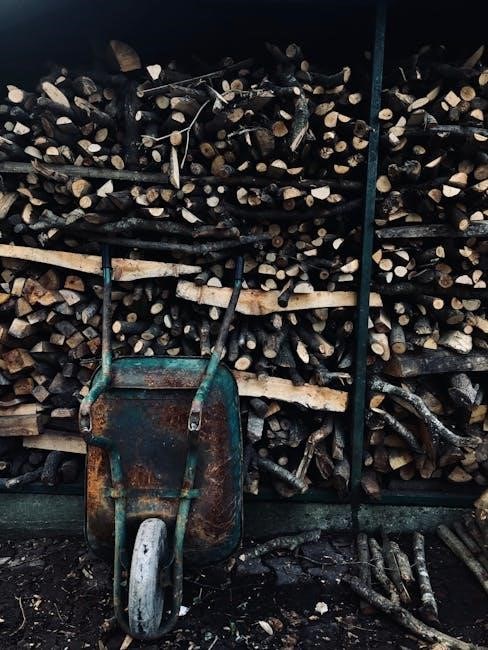
Roof Options for Firewood Sheds
Firewood sheds can feature gable or lean-to roofs. Gabled roofs offer better water runoff and durability‚ while lean-to designs are simpler and save space. Choose based on your needs and preferences.
Gabled vs. Lean-To Roofs: Pros and Cons
A gabled roof offers superior durability and water runoff‚ making it ideal for areas with heavy snow or rain. It provides more storage space and a traditional appearance. However‚ it requires more materials and complex construction. In contrast‚ a lean-to roof is simpler‚ cost-effective‚ and space-efficient‚ making it perfect for smaller sheds; It is easier to build but less durable and may not handle heavy snow loads well. Choose based on your climate‚ budget‚ and desired aesthetic. Both options are popular in firewood shed plans for their practicality and functionality.
Ventilation and Drainage
Proper ventilation ensures airflow‚ preventing moisture buildup and mold. Elevated designs improve drainage‚ keeping the shed floor dry and protecting firewood from rot. Essential for longevity and functionality.
Ensuring Proper Airflow and Moisture Control
Proper airflow is crucial for keeping firewood dry and preventing mold growth. Firewood shed plans often include designs with slatted sides and open fronts to maximize ventilation. Elevated floors‚ constructed with treated lumber‚ help prevent moisture from seeping into the shed. Some plans incorporate hurricane clips for added structural integrity and weather resistance. A lean-to roof design allows snow to slide off‚ reducing the risk of water accumulation. These features ensure your firewood remains dry and well-ventilated‚ extending its usability and protecting your investment. Detailed instructions in PDF plans guide you through implementing these moisture-control strategies effectively.
Budgeting and Cost Estimation
Estimate material and labor costs based on shed size and design. Plans often include cost-effective options‚ with free PDF downloads helping maximize savings and efficiency.
Estimating Material and Labor Costs
Estimating costs involves calculating materials and labor expenses. Firewood shed plans often include detailed material lists‚ helping you budget accurately. Compare supplier prices for lumber‚ hardware‚ and tools to minimize costs. Labor costs vary depending on skill level and location. Free PDF plans may suggest cost-effective designs‚ while premium plans offer detailed breakdowns. Consider DIY savings or hiring professionals. Factor in local taxes and potential permits. Some plans include cost estimates‚ ensuring transparency. Plan ahead to avoid overspending and ensure your project stays within budget‚ whether you’re building a small or large firewood shed.
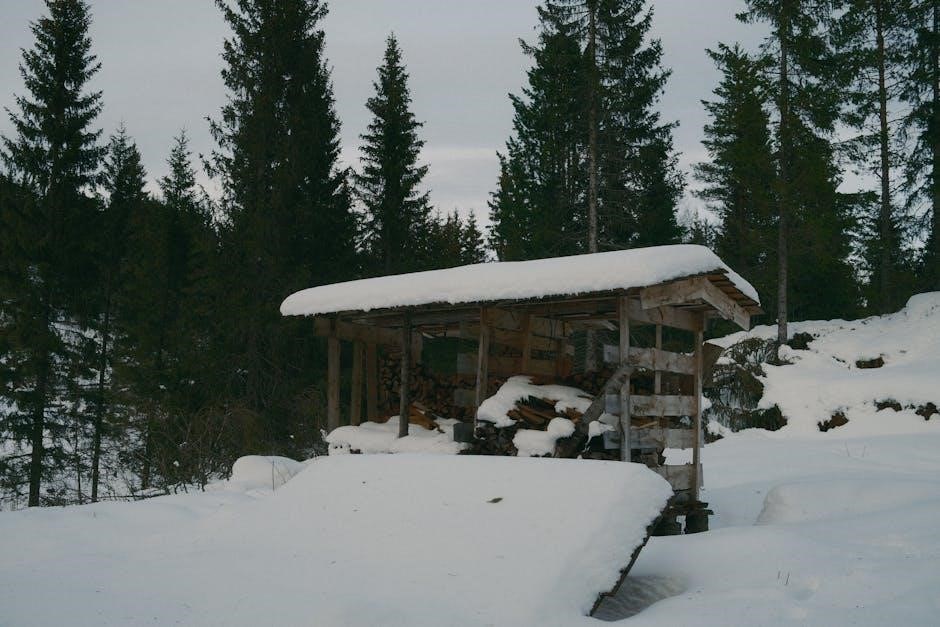
Safety Considerations
Ensure safety by following clear instructions and using proper safety gear. Secure construction prevents accidents‚ while protective equipment safeguards during assembly. Always adhere to local building codes.
Best Practices for Safe Construction and Use
Ensure a safe building process by wearing protective gear like gloves and safety glasses. Use proper tools and follow the PDF guide meticulously to avoid errors. Keep children and pets away during construction. Maintain a clean workspace to prevent tripping hazards. Regularly inspect the shed for structural integrity and address any weaknesses promptly. Store firewood off the ground to prevent moisture damage and pest infestation. Always follow local building codes and regulations. Proper ventilation is crucial to prevent moisture buildup and ensure dry firewood. Regularly maintain the shed to ensure longevity and safety.
Maintenance and Upkeep
Regular inspections‚ cleaning‚ and treating for pests are essential. Check for leaks and ensure proper ventilation to maintain dry firewood. This ensures longevity and efficiency.
Regular Maintenance for Longevity
Regular maintenance is crucial to ensure your firewood shed remains durable and functional. Inspect the roof and walls for leaks or damage‚ and address them promptly. Clean out debris and dirt from the floor and shelves to prevent moisture buildup. Check for signs of pests‚ such as termites or rodents‚ and treat the area if necessary. Ensure proper ventilation by keeping vents clear and maintaining airflow. Seasonally‚ inspect the foundation and re-tighten any loose screws or bolts. Applying a protective sealant or stain to the wood can also extend the shed’s lifespan‚ protecting it from weathering and rot.
Comparing Different Firewood Shed Plans
Firewood shed plans vary in design‚ size‚ and complexity. Compare free and premium options‚ considering factors like cost‚ detailing‚ and suitability for your specific needs.
Free vs. Premium Plans: What’s the Difference?
Free firewood shed plans typically include basic designs‚ material lists‚ and step-by-step instructions‚ often in PDF format. They are great for simple projects but may lack detailed diagrams or advanced features. Premium plans‚ on the other hand‚ offer comprehensive guides with 3D diagrams‚ precise measurements‚ and customization options. They cater to more complex builds and provide better support for unique designs. While free plans suffice for small-scale storage‚ premium plans are ideal for larger or tailored sheds‚ ensuring durability and aesthetic appeal. Choosing between them depends on your budget‚ skill level‚ and specific storage requirements.
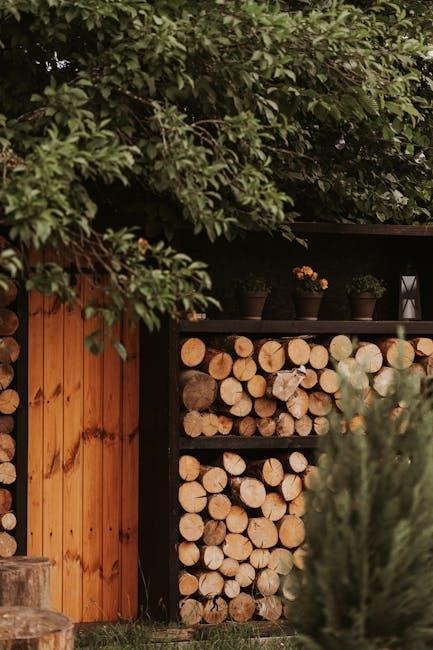
Case Studies and Real-World Examples
Real-world examples include an 8×16 shed storing 5 cords and a 48-inch lean-to design. These projects showcase practical solutions for firewood storage and protection.
Successful Firewood Shed Projects
Many homeowners have successfully built firewood sheds using downloadable PDF plans. For example‚ an 8×16 shed stores up to 5 cords‚ while a 48-inch lean-to design saves space. These projects often feature durable materials like treated lumber and include details like slatted sides for airflow. A 2×3 shed offers a compact solution for smaller needs‚ while larger designs incorporate features like pallet floors and steel roofs. Successful builds highlight the importance of proper drainage and ventilation to keep wood dry. These real-world examples demonstrate how shed plans can be customized to fit various yards and storage requirements effectively.
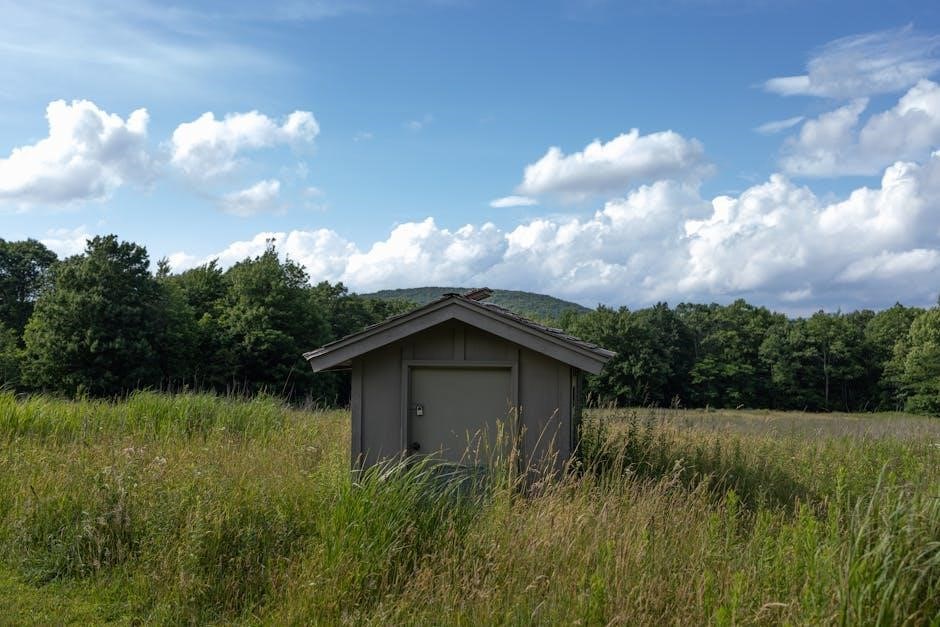
Creative Ideas and Customizations
Add personal touches like slatted sides‚ two-tone roofs‚ or decorative trims. Incorporate shelves or bins for kindling and tools. Use durable materials like treated lumber or steel for longevity. Customize sizes‚ colors‚ and styles to match your home or yard aesthetic‚ ensuring functionality while enhancing visual appeal.
Adding Personal Touches to Your Shed
Enhance your firewood shed’s functionality and charm by adding personal touches. Consider installing windows for natural light or shelves for storing kindling and tools. A two-tone roof or decorative trims can elevate the design. Use durable materials like treated lumber or steel for longevity. Paint or stain the shed to match your home or garden aesthetic. Add a lock for security or a ramp for easy access with a wheelbarrow. Incorporate slatted sides for ventilation or a lean-to roof for a rustic look. These customizations make your shed both practical and visually appealing‚ ensuring it complements your outdoor space while meeting your specific needs.
Firewood shed plans provide a practical and cost-effective solution for storing firewood efficiently. With numerous free and premium PDF designs available‚ homeowners can choose a plan that fits their space and needs. These plans often include detailed instructions‚ material lists‚ and customizable options‚ making it easier for DIY enthusiasts to construct a durable shed. By following these guides‚ you can ensure your firewood remains dry and organized‚ while also enhancing your property’s appearance. Whether you opt for a simple lean-to design or a larger storage shed‚ these plans help you achieve a functional and stylish firewood storage solution.